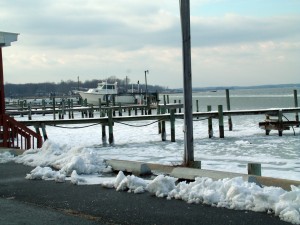
We thought a change of scenery would provide interesting nautical information and lifestyles, so we traveled east—to Chesapeake Bay on the East Coast.
We’ve traveled the Baltimore, Maryland inner harbor, several Chesapeake Bay locations and the Potomac. As the weather is unseasonably cold, (usually 0 to 20-degrees,) the numerous marinas we have observed have ice surrounding the berthed vessels from the shoreline bay ward hundreds of feet. The Potomac is frozen over from one shoreline to the other.
When we visited Baltimore Harbor, the tall ship Independence, which is the only warship afloat that fought in the Civil War, had been removed for repairs. Also included in this area is the only vessel, in this case Coast Guard, afloat that fired at the Japanese airplanes in the Hawaiian attack in 1941.
A WWII submarine and a retired Coast Guard lighthouse ship complete the historical fleet. While the signs said viewing at 10 a.m., these displays were deserted and unattended. The slight winds off Chesapeake Bay and 15-degree air temperatures were so cold on our exposed faces it actually hurt.
Next, our Air Force guide navigated us to the U.S. Navy Museum on a Navy base beside the Potomac. This fascinating facility was formerly a bomb-making armory, now a museum. Outside the front of the building were British and American ships cannons from the Revolutionary Days to World War II. Inside were displays of nautical artifacts from the 1700s to World War II. These included uniforms, hand weapons, photographs from the 1800s and 1900s and models of ships, PT boats, destroyers and aircraft carriers of notable historic value.
Along the Southern Maryland shore we visited the Solomon Island area, which is actually a Peninsula, not an island. The commercial oyster fleet was iced in along the pier that acts as their home berths. Beside that area was a small shipyard and marina. Low and behold I recognize a familiar style sloop I admired in my youth.
In the early 70s, Judy and I accompanied Harbor High buddy, Gary Jackson, and his soon to be wife on their family 22-foot sloop to Catalina. At the time this size vessel (and even smaller) were quite common to travel to the Island.
I commented on my envy of the Costa Mesa built Columbia 26-foot sloop mooring next to us. The small cabin top allowed the owners to stand up, cook and possibly visit the head. For this size sailboat to be able to stand up and put your pants on was a real luxury that, at the time, I missed.
As I have written about many times, locally built fiberglass boats, whether power or sail, are still being cruised all over the U.S. and distant locations.
Another local reminder in the D.C. area was the William Gross Stamp Collection at the Smithsonian Museum. Yes, that same individual is the former Pimco founder and Women’s Pavilion benefactor at our Hoag Hospital.
Sea Ya,
Skipper Steve




